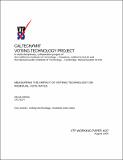| dc.contributor.author | Grigg, Delia | |
| dc.date.accessioned | 2015-04-14T19:42:57Z | |
| dc.date.available | 2015-04-14T19:42:57Z | |
| dc.date.issued | 2005-08 | |
| dc.identifier.uri | http://hdl.handle.net/1721.1/96574 | |
| dc.description.abstract | In the wake of the 2000 election, the importance of knowing the impact of voting equipment on the number of uncounted ballots became evident. Using data from the 1988-2004 presidential elections, this paper estimates the effects of voting technologies on residual vote rates using several measurement techniques: a difference-in-differences estimator, fixed effects regression models and a propensity score matching technique. The pattern of the results is robust to the different methods. Paper ballots and lever machines produce the lowest rates of residual votes followed by optically scanned ballots, direct recording electronic machines and punch cards. | en_US |
| dc.language.iso | en_US | en_US |
| dc.publisher | Caltech/MIT Voting Technology Project | en_US |
| dc.relation.ispartofseries | VTP Working Paper Series;37 | |
| dc.subject | Voting technology | en_US |
| dc.subject | Residual vote rates | en_US |
| dc.title | Measuring the Impact of Voting Technology on Residual Vote Rates | en_US |
| dc.type | Working Paper | en_US |
